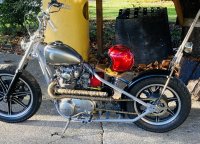PMA Reg/Rectifiers have 2 types. Shunt and series.
Shunt reg/rect
The regulator part controls the amount of power going to the battery. If the PMA is a 200 watt and the bike is using 130 watts then 70 watts is being made but not going anywhere. This gets converted to heat and the cooling fins bleed this off. If the fins cant get rid of the excess heat/power fast enough the Reg/Rect unit lets any excess heat back into the line to the PMA and over heats the Stater.............. So the stater is making power to feed the reg/rect ,(but that is feeding any excess power converted to heat), it cant shunt off, back in to the stater causing it to burn out.
if you put LED lights all through the bike with a PMA then the bike will be using less Wattage. That means a bike that is usually using 130 watts could be saving 20-30 watts so now it is only using 100-110watts of the 200watts. So a 200 watt PMA Reg/rect instead of bleeding off 70 watts now has to convert 90-100 watts to heat, making it more likely to cause the reg/rect to overheat and burn out the stater
Series Reg/Rect.
The series Reg part of the Reg/rect controls the amount of power to the battery. The PMA still puts out 200 watts and if 130watt's is being used then 70 watts is the excess..........On the series Reg/Rect the regulator controls the amount of power to the battery, so it doesn't get to much, (same as the shunt Regulator).
The PMA still puts out 200 watts continuously. The difference is the series regulator shuts down one of the 3 phases (coming from the stater, white/yellow wire), for a short period of time. It then swaps over to another 2 of the 3 wires and receives power from those 2 for a short time. It keeps swapping wires so only 2 phases are being used at a time and drops the feed from one phase. This means there is less excess power the Reg has to convert to heat so the cooling fins have less to bleed off and stops any excess being feed back to the stater so the stater doesn't burn out.
If by any chance the battery is failing and the bike need more power to run the series reg will go back to using the 3 wires, (3 phases), to feed the power into battery to feed the bike.

